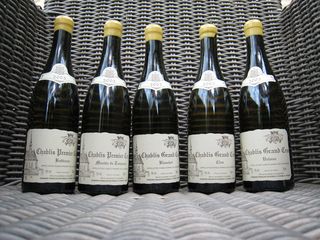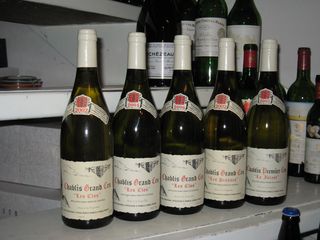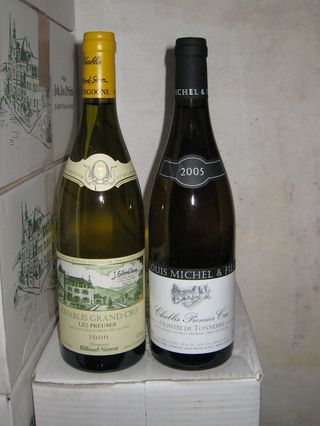Chablis is a long-standing favourite of mine, A stand-by also in many ways. I love it and there was a time when Chardonnays from all over the world called themselves Chablis to gain popular acclaim. In recent times however, Chablis seems to have been experiencing an identity crisis. In this post I will try to extol its glories, discuss its difficulties and give you some tips for choosing Chablis for drinking at home or in restaurants.
I couldn't possibly describe the glories of Chablis better than Clive Coates MW does, when he writes: "Chablis, at its best, is a magnificent wine and is quite unique. The colour should be a full, in the sense of quite viscous, greeny-gold. The aromas should combine steeliness and richness, gun flint, grilled nuts and crisp toast. The flavour should be long, individual and complex. Above all the wine should be totally dry, but without greenness, ample rather than hard, generous rather than soulless. Chablis is an understated wine, so it should be subtle rather than obvious, reserved rather than too obviously charming." (The Wines of Burgundy, Clive Coates MW, UOC Press 2008, page 49).

This description sounds very appetising indeed, but it also makes clear that Chablis is not necessarily an easy wine to appreciate. Chablis is made from Chardonnay, but it isn't big and easy, it doesn't have exotic fruit or lavish oak. It is the antithesis of new world Chardonnay. But there was a time when we all wanted just that. And (mistakenly) Chablis made a half-hearted attempt to adapt. But before we get into that, here are some basics about Chablis.
Chablis is in the northeast of France, halfway between Paris and Dijon on chalky soils (Kimmeridgian) that define its character. There are (figures 2005) 4,755ha of Chablis in total, divided into 713ha of Petit Chablis, 3,163ha of Chablis, 775ha of Chablis Premier Cru and 104ha of Chablis Grand Cru. Petit Chablis is not a wine to get worked up about - dry, fresh and simple, best drunk young. Chablis tout court can be very average, but it can also be remarkable. It can be the delicious essence of its terroir in a perfectly simple, dry and minerally way, like the 2008 from the excellent Beaune-based négociant Seguin-Manuel. A dream with seafood. But it can also aspire to greatness, like the deep and powerful 2002 from Vincent Dauvissat.

Chablis Premier Cru is perhaps the most typical expression of Chablis. Some of the Premier Crus are in side valleys on the left bank of the river Serein (Montmains, Vaillons, Côte de Lêchet), some are on the right bank adjacent to the Grand Crus (Fourchaume, Montée de Tonnerre, Mont de Milieu). They combine style, elegance and intensity and are usually very reasonably priced for a wine of this quality level.
The 7 Grands Crus are truly in a class of their own. Les Clos is the greatest of them all. They occupy a single block of vines on a magnificent slope northeast of the town of Chablis (see picture above). These wines can attain a magical character of almost Sauternes-like honeyed richness in a bone-dry mineral setting. They require patience however, as they take up to 10 years to express themselves and may last for several decades.

It sounds like a dream. A great grape variety on great terroir. What more could you want? The popularity of Chablis however, has caused producers to compromise quality. They overproduce machine-harvested wines which they over-manipulate. This is still a major problem. You can't do without careful winemaking and a lot of very average Chablis is put onto the market. Not only Chablis' quality is being compromised however, but also its identity. A few years ago, producers were trying their hand on new oak to adapt to modern tastes. This seems to have mostly ceased. Chablis and new oak just don't work. Chablis is not Meursault. People don't only like Meursault however, they also like New Zealand Sauvignon Blanc. And nowadays some Chablis tries to mimic that, believe it or not. What you end up with is wines like the Chablis Vaillons 2007 from Laroche which I tried recently. The nose was very much as if the wine was from Marlborough, but at the same time the flavour was dry and minerally and it tailed off. Clearly not the right way to go.
So as always it's about sticking to the right producers who will just allow the wine to be what it is - glorious Chablis in its own right. Some use stainless steel only (most vociferously Louis Michel), some use old oak, like Raveneau and Dauvissat - two of the greats. Other good producers whose wines you might encounter are Billaud-Simon, Jean-Marc Brocard and William Fèvre. La Chablisienne, the local cooperative is very dependable too. White Burgundy specialist Jean-Marie Guffens turns out some wonderful Chablis under the Verget label - check out his Vieilles Vignes des Minots and Vieilles Vignes de Vaulorens. Finally, the Chablis from the major Beaune-based négociants Louis Jadot and Drouhin is usually very good too.

In a restaurant I will often choose Chablis Premier Cru from a good producer when it is on the wine list. It usually delivers good quality at a reasonable price. Cheaper than your average Meursault, much more interesting and very versatile food-wise. It will usually be quite young, but that doesnt tend to get in the way. It's lovely at any age. Chablis Grand Cru is more difficult - it takes its time. Only go for aged wines, but when you find them on a wine list, do not hesitate! In Hotel Die Swaene in Bruges I recently had a Les Clos 2002 from Vincent Dauvissat - very fine albeit still very young, but lovely with lunch on the terrace. Don't bother with young Grand Crus in a restaurant - drinking them amounts to infanticide; get them for your cellar and wait for them to develop, while you enjoy the occasional bottle of Premier Cru!
Xavier Auerbach












